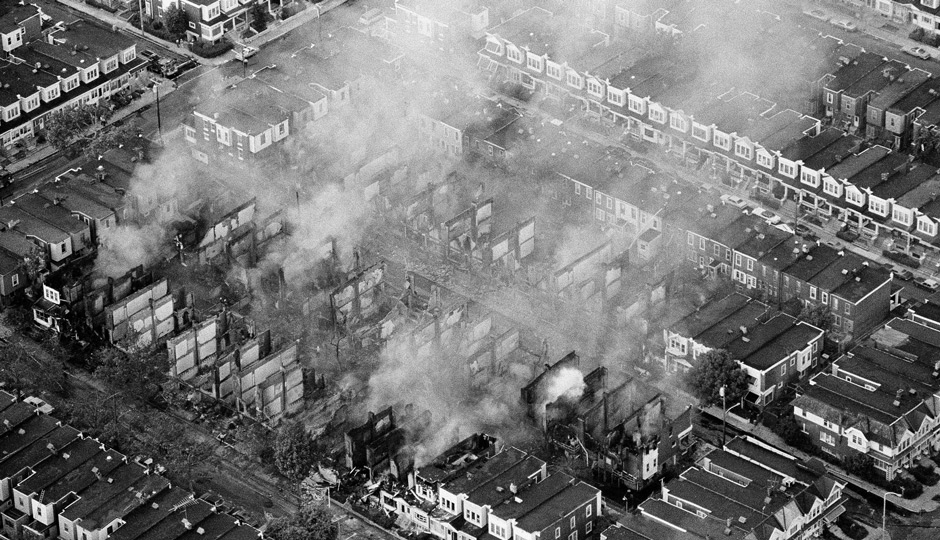Thirty Years Later, MOVE Still Hurts

Peter Morgan | AP
On May 13, 1985 — 30 years ago today — a city decided to selectively bomb its citizens. On Mother’s Day 1985, residents on a block at the edge of the city of Philadelphia were ushered out of their homes, assured that they would soon return to the quiet lives they’d previously known. Days earlier, 6200 Osage Avenue residents had demanded City Hall take action about the radical anarchist group — MOVE — that had relocated to the block. City officials were perplexed — the earlier 1978 bloody takeover of MOVE headquarters in West Philadelphia had left one policeman dead and nine jailed — and decided to evict the group from its house. The next day, then-police commissioner Gregore J. Sambor approached the barricaded neighborhood and bellowed through a bullhorn: “Attention, MOVE. This is America.”
By 6 a.m., the first shots rang out. Next, water cannons and tear gas were targeted on the fortified 6221 Osage property. Twelve hours later, as much of Philadelphia watched on TV, a state police helicopter dropped a powerful military explosive on the rooftop bunker. As the fire was deliberately allowed to spread through the neighborhood, two MOVE members escaped – Ramona Africa and the then-13-year-old known as Birdie Africa — and 11 others, including founder John Africa, were burned alive. Ultimately, 53 homes were destroyed, eight others were damaged, and all 61 were razed.
30 years later … and it still hurts. The communal malfeasance that occurred in the singular dropping of a bomb and the subsequent decision to let the area burn is still utterly mind-numbing. Philadelphia’s founding principles are based on religious and ideological acceptance, so when MOVE first popped up in the ’70s it was just another group in the line of so many that called the city home. MOVE’s back-to-nature stance, enhanced by a raw diet and the incorporation of dreadlocked natural hair, meant it was deemed a hippie-like organization with college-age kids finding their voice. For months, then years, members would take to City Hall’s courtyard with bullhorn in hand and verbally fire up elected officials, judges, and, of course, then-Mayors Frank Rizzo and W. Wilson Goode. As the group grew and became more politicized, city officials became more polarized and, eventually, things became more violent.
The recently released documentary Let The Fire Burn reveals there were a whole lot of wrongs in 1985. Eventually, 11 years after the bomb was dropped, a court ruled that “the city, former Police Commissioner Gregore Sambor and former Fire Commissioner William Richmond used excessive force and violated the MOVE members’ constitutional protections,” CNN reported in 1996. These entities were ordered to pay $1.5 million to one survivor and two family members of deceased MOVE members.
Despite all of this, MOVE did not disappear. Although no testimony was presented indicating Ramona Africa ever held or fired a weapon, she was charged and jailed for seven years. Since her release in 1992, Africa has continued to serve as the organization’s primary spokesperson, advocating for the jailed MOVE Nine and Mumia Abu-Jamal, convicted in the 1981 murder of Philadelphia Police Officer Daniel Faulkner. MOVE members, some the great-grandchildren of early MOVEers, still live communally in West Philadelphia and travel extensively to participate in peaceful protests. However, review MOVE’s online presence (http://onamove.com) and it appears the organization is stuck in a time warp that begins and ends with the events of May 13th. The site’s most prominent merchandise are two t-shirts embossed with an image of a hovering helicopter dropping the “incendiary device” on the roof of the rowhome.
•
IN THE 30-YEAR aftermath, a lot has changed. Nearly the entire 6200 block of Osage Avenue today is largely disregarded as its ramshackle shells sit on the edge of a city that wishes it would go away. The then-mayor is now addressed as Rev. W. Wilson Goode, and leads a Baptist Church in Southwest Philly, not far from Osage Avenue site. The Rev.’s website bio, however, carefully sidesteps any mention of the MOVE calamity.
As for MOVE, there was a personal resonance for me as a young radio reporter trying to negotiate family and career: I left this city after the 1985 incident; I was determined not to raise a child in an environment that fostered regular racial confrontations. I moved to Watertown, New York, in 1987 and I begrudgingly came back in 1991 with my husband and toddler son. When I returned, the situation here was far worse than in the MOVE days. Crack had invaded and parts of the city were in abject neglect. I moved away, in part, because of MOVE, and I returned out of a sense of duty, and stayed because of a sense of purpose.
I didn’t know just how deeply the 1985 incident still resonated until I posted on Facebook last year and the emotions — along with forgotten memories — surfaced, for myself and scores of others. MOVE is still a hurt piece for Philadelphians.
While it took days to extinguish the fire that raged there in 1985, in reality it has smoldered for decades.
And it still hurts.
Follow @BobbiBooker on Twitter.
Previously: MOVE: An Oral History
Previously: Birdie Africa: The Lost Boy
Previously: One of Us: Ramona Africa, MOVE Member
Previously: Speaking With the Director of MOVE Documentary Let the Fire Burn


